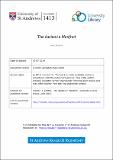Files in this item
The Dashes in Manfred
Item metadata
| dc.contributor.author | Stabler, Jane Susan | |
| dc.date.accessioned | 2019-07-19T11:30:04Z | |
| dc.date.available | 2019-07-19T11:30:04Z | |
| dc.date.issued | 2019-06-01 | |
| dc.identifier | 256276902 | |
| dc.identifier | 6ac34e46-ae7f-4bcc-a283-707213fd8213 | |
| dc.identifier.citation | Stabler , J S 2019 , ' The Dashes in Manfred ' , Romantic Circles Praxis , vol. June 2019 , 9 . < https://romantic-circles.org/praxis/manfred/praxis.2019.manfred.stabler.html > | en |
| dc.identifier.issn | 1528-8129 | |
| dc.identifier.uri | https://hdl.handle.net/10023/18135 | |
| dc.description.abstract | “The Dashes in Manfred” examines the ways in which one aspect of Byron’s manuscripts has been translated by his editors. The dash is one of the most distinctive and controversial features of Byron’s writing and is the vehicle for the silent part of his voice. Like many other editors, I think that accidentals can be substantive. In this paper, I look at the cultural associations of the dash, its translation from manuscript into print in Byron’s particular case, and the different versions of Manfred that come into sight (and hearing) if we use Byron’s manuscripts as a musical score. | |
| dc.format.extent | 4672985 | |
| dc.language.iso | eng | |
| dc.relation.ispartof | Romantic Circles Praxis | en |
| dc.subject | PE English | en |
| dc.subject | T-NDAS | en |
| dc.subject | BDC | en |
| dc.subject | R2C | en |
| dc.subject.lcc | PE | en |
| dc.title | The Dashes in Manfred | en |
| dc.type | Journal article | en |
| dc.contributor.institution | University of St Andrews. School of English | en |
| dc.contributor.institution | University of St Andrews. Centre for Ancient Environmental Studies | en |
| dc.description.status | Peer reviewed | en |
| dc.identifier.url | https://romantic-circles.org/praxis/manfred/praxis.2019.manfred.stabler.html | en |
This item appears in the following Collection(s)
Items in the St Andrews Research Repository are protected by copyright, with all rights reserved, unless otherwise indicated.

